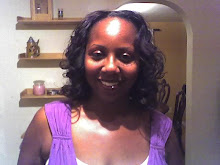Recently I have been volunteering to do deaf-blind interpreting which is very different . One thing I had to learn is that each Deaf-Blind (DB) person's needs is different. There could be a person who is Deaf but gradually lost their sight, or gradually losing their sight; there could be a person who is Blind but gradually losing their hearing; or a person who has recently become deaf and blind. The combinations can go on and on but the point is that working with a DB person requires the ability to be flexible.
For the Registry of Interpreters' standard of Deaf-Blind interpreting please follow this link: www.rid.org/UserFiles/File/pdfs/Standard_Practice_Papers/Drafts_June_2006/Deaf-Blind_SPP(1).pdf.
For now though, I would like to share my recent experiences working with one particular DB person. This person is tactile. According to our industry's standard referenced above, tactile means, "�� sign language received by sense of touch with one or two hands (tactile) �� fingerspelling received by sense of touch (tactile)." I will use the pseudo name, Francesca.
Attention getting with Francesca is little different. Unlike deaf individuals that may prefer a tap on the shoulder, with Francesca, I lightly bump my hand with hers to indicate, "Hey, there, I'm here." Most times Francesca "answers" by signing, "Who?" Whereas a Deaf person could see "Who?", a DB person can not see "Who;" thereby the need to CONSISTENTLY identify individuals when they are "speaking/signing." I answer by placing my dominant hand under her left hand and articulate my sign name. Then cordialities are exchanged.
The discourse is preceded with an ASL song. As the audience stands to "sing" the ASL song, Francesca stands but turns to face me. She has made the decision to use both of her hands so that she can "track" what I am signing. This means she will place her hands on top of mine as I am copying the ASL song being played from a DVD. This can be tricky because there are signs and grammar that are on the face or head that a DB person cannot see. There is a constant consideration as to how this will be executed (what linguistic equivalent can be used?) Negations and emotions are a few examples. Vigilance is key.
Once the song is finished, the audience takes their seats and now its time for the discourse. Francesca likes to know the name of the presenter, where he is from, and what medium is he using (iPad or paper outline, or pictures). One thing that impresses me in this process is that Francesca is able to ascertain if the speaker is new to Sign language or not.
At one time in her life, Francesca was able to see enough and was an art major. As her sight deteriorated, things changed. Knowing this helps me know that when pictures are used during the ASL songs or the discourse, I can describe color to Francesca and she can paint a similar thought image in her mind's eye.
At another meeting, the logistics are a little different than the discourse explained above. The reason being this meeting is now opened to the public for their comments. The discourse has a one directional flow of information. But when the public is involved other consumer needs come into play. For example, Francesca likes and demands (as consumers we all demand or "order" what we want, right?) knowing who is speaking and what general direction they are sitting. If there is a change in audience seating, this needs to be conveyed.
Francesca has a hearing dog. Similar to a seeing eye dog, this dog leads her around. So unlike SSP, when I am working with Francesca, I do not have to lead her around. Her dog does that job. There are times though when Francesca wants to meet a specific person. Maybe I have informed her during the meeting that there are visitors or new faces that are not familiar. Sometimes she will ask me or others to lead her to such ones.
At a party a spotted Francesca dancing with her non-deaf husband who is uber fluent is ASL. She was doing the electric slide.
This woman, her husband, and her dog have gone and done so many things. In fact, she has lived in Honduras and there too, she was very independent!
Another amazing thing is when we go to Starbucks or the like, Francesca doesn't depend on others to order for her. She has a machine that she carries cross-body (like a messenger style bag) that she uses to receive emails, text messages, and she uses gps. I don't know the name of the device but it sends and receives signals from her personal devices and converts those signals to a signal to this device that will help her "read" messages. This hip device converts the signals to Braille. Her hip device uses pins that automatically convert to Braille and it scrolls across. I am sure I am not explaining this awesome experience clearly but believe me it is jaw dropping.
There are so many other nuances that just floor me working with Francesca. I am biased. Yes, working with Francesca is one of my secret joys. But I need to experience others. What are their preferences? How do I work with each one of them? One strong resource if you are interested is Ms. Rhonda Jacobs. Check RID website for her contact info and she can fill you in and get you connected to yet another spectrum of Deaf culture.
Until later,
Keep it Simple


















